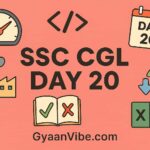GyaanVibe is a focused educational platform dedicated to helping SSC CGL aspirants crack Tier 1 & Tier 2 exam with a strategic, day-wise, and well-structured preparation approach.
SSC CGL Preparation – Day 14
History: Indian Freedom Struggle (1857–1947)
🔰 Introduction
The Indian Freedom Struggle was a long, multifaceted movement against British colonial rule. It included revolts, social and religious reform movements, moderate and extremist political activism, non-violent resistance, and revolutionary activities.
1. The Revolt of 1857 – The First War of Independence
- Causes: Political (Doctrine of Lapse), Economic (Heavy taxes), Military (greased cartridges), Religious (disrespect to Indian customs)
- Leaders:
- Mangal Pandey – Barrackpore
- Rani Lakshmi Bai – Jhansi
- Bahadur Shah Zafar – Delhi
- Tatya Tope, Nana Saheb, Kunwar Singh
- Result: Failed, but laid the foundation for national awakening
- Effect: East India Company abolished → Crown Rule began in 1858
2. Rise of Indian Nationalism
🔹 Political Associations Before Congress
- British Indian Association (1851)
- Indian National Association (1876) – founded by Surendranath Banerjee
🔹 Formation of Indian National Congress (INC)
- Founded in 1885 by A.O. Hume
- First Session: Bombay, President: W.C. Bonnerjee
3. Phases of the Freedom Movement
🟩 Moderate Phase (1885–1905)
- Leaders: Dadabhai Naoroji, Gopal Krishna Gokhale, M.G. Ranade
- Demands: Constitutional reforms, Indianisation of services
- Methods: Petitions, speeches, debates
- Dadabhai Naoroji: “Drain of Wealth” theory
🟥 Extremist Phase (1905–1919)
- Leaders: Bal Gangadhar Tilak, Bipin Chandra Pal, Lala Lajpat Rai (Lal-Bal-Pal)
- Slogan: “Swaraj is my birthright and I shall have it” – Tilak
- Movements:
- Swadeshi and Boycott Movement (1905) – Against Partition of Bengal
- Split in INC at Surat in 1907 (Moderates vs Extremists)
- Formation of Muslim League in 1906 (Dhaka)
⚔️ Revolutionary Activities
- Organizations: Anushilan Samiti, Ghadar Party, Hindustan Socialist Republican Association (HSRA)
- Leaders: Chandrashekhar Azad, Bhagat Singh, Rajguru, Sukhdev
- Notable Incidents:
- Alipore Bomb Case
- Kakori Train Robbery (1925)
- Saunders’ assassination (1928)
- Bhagat Singh hanged (1931)
4. Gandhian Phase (1919–1947)
🔹 Entry of Mahatma Gandhi (1915)
- Inspired by Tolstoy & South African Satyagraha
- Introduced Non-violent resistance (Satyagraha)
🔹 Major Movements under Gandhi
1. Champaran Satyagraha (1917) – Indigo farmers
2. Kheda Satyagraha (1918) – Tax relief for famine-affected farmers
3. Ahmedabad Mill Strike (1918) – Worker rights
🛑 Non-Cooperation Movement (1920–22)
- Causes: Jallianwala Bagh massacre (1919), Khilafat Movement
- Led by: INC under Gandhi
- Boycott of schools, colleges, British goods, law courts
- Chauri Chaura Incident (1922): Violence → Movement withdrawn
🇮🇳 Civil Disobedience Movement (1930–34)
- Trigger: Salt Law
- Dandi March (12 March 1930) – Gandhi broke salt law
- Boycott of foreign goods, refusal to pay taxes
✒️ Government of India Act 1935
- Provincial Autonomy
- Diarchy at Centre (never implemented)
🇮🇳 Quit India Movement (1942)
- Slogan: “Do or Die”
- Launched after failure of Cripps Mission
- Brutal suppression by British
- Gandhi, Nehru, and others jailed
🌍 Indian National Army (INA)
- Founded by Rash Behari Bose, revived by Subhas Chandra Bose
- Motto: “Give me blood and I will give you freedom”
- Fought alongside Japanese in Burma
- Trials of INA officers created mass support for independence
📝 Other Important Developments
🔹 Round Table Conferences (1930–32)
- Three sessions held in London
- Gandhi attended second session as INC representative
🔹 Cripps Mission (1942)
- Offered Dominion Status post-war → Rejected by INC
🔹 Cabinet Mission Plan (1946)
- Proposed federal structure and Constituent Assembly
📆 Events Leading to Independence
| Event | Year |
|---|---|
| INA Trials | 1945 |
| Royal Indian Navy Revolt | 1946 |
| Mountbatten Plan | 1947 |
| Indian Independence Act | 1947 |
🏳️ Partition and Independence
- Based on Mountbatten Plan (June 3, 1947)
- Two nations: India and Pakistan
- Indian Independence Act passed by British Parliament in July 1947
- India became independent on 15 August 1947
📌 Important Leaders and Organizations
| Name | Contribution |
|---|---|
| Mahatma Gandhi | Non-violence, Satyagraha |
| Subhas Chandra Bose | INA, Forward Bloc |
| Nehru | First PM, Role in INC |
| Sardar Patel | Integration of princely states |
| Annie Besant | Home Rule Movement |
| Lala Lajpat Rai | Protested Simon Commission |
| Bhagat Singh | Revolutionary |
| Gopal Krishna Gokhale | Mentor of Gandhi |
| Dadabhai Naoroji | Economic critique of British rule |
🧠 Keywords & Slogans to Remember
- Swaraj – Self-rule
- Satyagraha – Truth-force
- Do or Die – Quit India Movement
- Jai Hind – Subhas Bose
- Vande Mataram – Bankim Chandra Chattopadhyay




